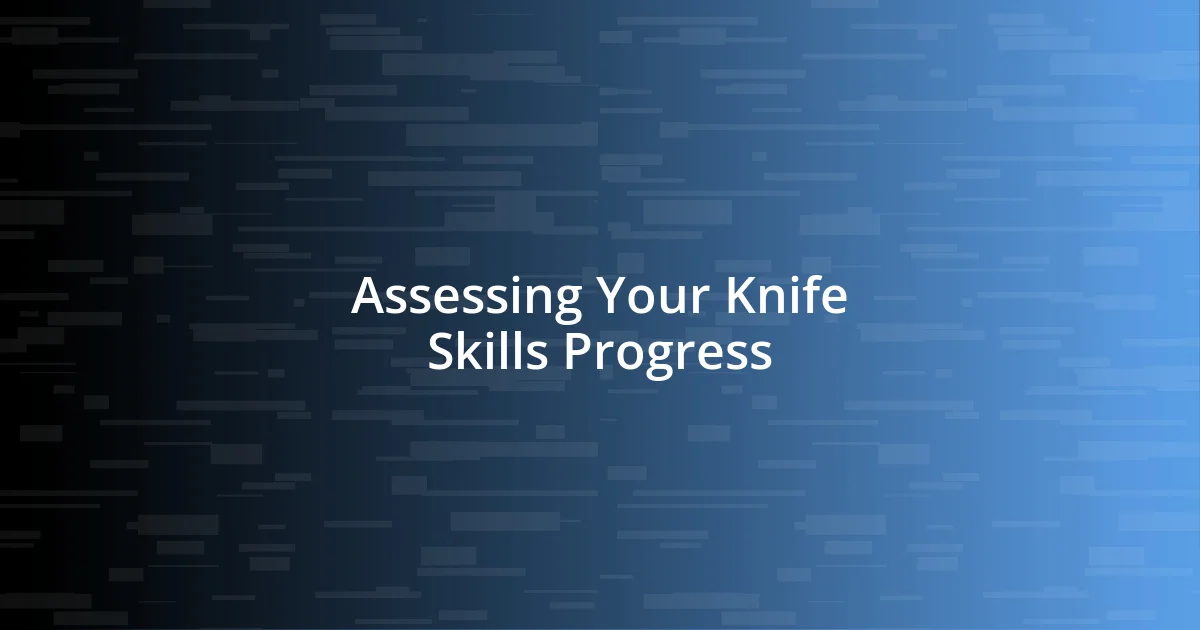Key takeaways:
- Mastering knife skills boosts confidence and transforms cooking from a chore into a creative outlet.
- Common mistakes include using the wrong knife, poor grip technique, and improper cutting motions, all of which can hinder efficiency and safety.
- Practicing specific exercises and maintaining an organized workspace enhances control and cutting speed, leading to improved culinary skills.

Understanding the Importance of Knife Skills
Knife skills aren’t just about precision; they embody confidence in the kitchen. I recall the first time I diced an onion without shedding tears. The triumph I felt was immense and reminded me that mastering knife techniques can transform a daunting task into a satisfying experience.
When I watch someone struggle with a blade, I can’t help but wonder: what if they understood the fundamentals? Proper knife skills not only boost efficiency but also enhance safety. A well-chopped vegetable is far less likely to slip under a clumsy hand, which is something I’ve learned the hard way.
Additionally, having good knife skills elevates the entire cooking experience. I’ve noticed that with every chop, slice, and dice, I become more connected to the food I prepare. It’s almost meditative, isn’t it? Reflecting on my own journey, I realize these skills have turned cooking from a chore into a creative outlet, allowing me to express myself with each ingredient.

Common Mistakes in Knife Skills
When it comes to knife skills, one of the most prevalent mistakes I see is using the wrong type of knife for the task. I remember the first time I tried mincing garlic with a chef’s knife instead of a paring knife. The struggle was real! It not only took longer but also resulted in uneven pieces. Using the right knife not only affects the efficiency of your prep time but also impacts the outcome of your dish. Choosing the appropriate blade for each job makes a world of difference.
Another common error is holding the knife in a way that restricts control and comfort. I still chuckle when I think about the awkward grip I used to adopt—my fingers tensed and hands uncertain. It took some time to understand that a relaxed grip fosters better control. You can slice more accurately, and the process becomes a lot smoother. Remember, your hands are your best tools, so treat them well!
Lastly, many tend to overlook the importance of proper cutting technique. I can’t tell you how many times I’ve witnessed people saw back and forth rather than using a smooth rocking motion. This not only increases the risk of accidents but can also lead to unintentional bruising of delicate ingredients. A steady, rhythmic technique promotes better cutting results and keeps your fingers safe. It’s all about finding that balance between speed and precision.
| Common Mistakes | Impact on Knife Skills |
|---|---|
| Using the wrong knife | Leads to inefficiency and uneven cuts |
| Poor grip technique | Causes lack of control and comfort |
| Improper cutting technique | Increases risk of accidents and affects ingredient quality |

Techniques to Improve Cutting Speed
Improving your cutting speed is all about technique and practice. I remember a time when I would dread the chopping process, feeling like I spent half my day in the kitchen. Then I discovered the importance of rhythmic movements. By focusing on developing a consistent chopping pattern, I found that not only did my speed increase, but I also began to enjoy the process more.
Consider trying these techniques to help enhance your cutting speed:
- Practice the Rocking Motion: This involves using the tip of the knife as a pivot while the heel moves up and down in a smooth rocking manner. It feels more fluid and allows for quicker, more uniform cuts.
- Keep Your Knives Sharp: Dull knives require more force, leading to slower cuts. Investing in a good sharpener has truly transformed my experience.
- Pre-Chop Ingredients: If I know I want to make a salad, I’ll chop my veggies into smaller sections in advance. Not only does this speed things up, but it also makes for a more visually appealing dish.
- Limit Distractions: When I concentrate solely on my chopping, I feel like a maestro in the kitchen—speed and efficiency follow naturally.
Practicing a few minutes each day can also make a world of difference. I often set a timer to see how quickly I can chop certain items. The satisfaction I feel watching my knife work its magic fuels my passion for cooking further.

Safety Tips for Using Knives
When using knives, the first safety tip that I can’t stress enough is to keep your workspace organized. I’ve had moments where my cutting board was cluttered with ingredients, and it led to some near mishaps. Picture this: you’re mid-chop and suddenly your elbow knocks over a spice jar. What a panic! It’s far easier to maintain control when you have a clear space, which lets you focus on what you’re doing without distractions.
Another important aspect is wearing cut-resistant gloves, especially if you’re just starting. I remember the first time I used a mandoline for slicing vegetables. That device scared me a bit, and honestly, wearing those gloves gave me the courage to press on. These gloves can offer protection against accidental slips and help you gain confidence in your slicing technique. If that extra layer can alleviate fear while you’re learning, why not put it on?
Lastly, it’s critical to cut away from your body and to stay focused. I’ve had moments where I was chatting away and almost lost control—just one little slip and it could’ve been bad. It’s easy to think multitasking is a win, but when using a sharp blade, your full attention is vital. Trust me, when you make cutting a mindful practice, it not only enhances safety but also improves your overall skills.

Tools That Enhance Knife Skills
Tools that enhance knife skills can truly make a difference in how confidently you navigate your kitchen. For instance, a good quality cutting board is essential; I remember when I switched to a sturdy wooden board. It provided a stable surface that helped me develop my technique without the worry of my board slipping around. The right board can also absorb the impact of your knife, reducing wear on the blade.
Then there are knife guides, which I initially overlooked. I didn’t think I needed one until a friend suggested it during a cooking session. Using a knife guide brought a sense of structure to my cutting technique, almost like using a training wheels. I could visualize the exact angle and pressure to apply, allowing me to approach each chop with precision. Have you ever found something that transformed your learning experience? That’s what this little tool did for me.
Lastly, don’t underestimate the value of a good knife itself. When I upgraded to a chef’s knife that fit comfortably in my hand, I felt an immediate shift in my confidence. It’s as if I had finally found my culinary partner! With the right grip and balance, I began to enjoy the rhythm of chopping, turning what used to feel like a chore into a delightful part of the cooking process. Every slice felt purposeful, and I truly believe that having the right tools empowers you to become a better cook.

Practice Exercises for Better Control
Practicing knife skills is all about gaining control, and one effective exercise I recommend is the “Paper Test.” Grab a piece of paper and practice slicing through it with smooth, even cuts. I remember the first time I did this; I was surprised at how it highlighted my grip and pressure. If I pushed too hard, I’d rip the paper. The challenge of maintaining consistency made me more aware of my movements, refining my technique while having fun with a simple piece of paper.
Another great exercise involves the “Chop and Stack” method. Take a handful of vegetables, chop them into even pieces, and then stack them neatly. This not only improves the precision of your cuts but also keeps you grounded in the process. I still recall the satisfaction I felt when I carefully stacked my diced onions, feeling that sense of accomplishment wash over me. Have you ever experienced that moment where you realize you’re really mastering a skill? It’s a little victory that fuels your motivation.
Lastly, don’t forget the importance of repetition with the “Slow-Mo Chop.” This involves working at a snail’s pace to focus on technique rather than speed. I often catch myself starting out too quickly due to excitement, but when I consciously slow down, I truly pay attention to my form and posture. Trust me, embracing this tempo helped reshape my approach to knife skills. What might you discover about your method when you take a step back? You might unveil new layers of improvement you never knew existed!

Assessing Your Knife Skills Progress
When assessing your knife skills progress, it’s essential to reflect on your journey. I recall being frustrated at times, feeling like I wasn’t making any headway. But then I started keeping a journal of my chopping sessions. Not only did this help me track my improvements, but it also revealed how quickly I managed to chop tomatoes or dice an onion with less effort than before. Have you ever monitored your progress like this? It can be eye-opening.
Video can be a powerful tool, too. I began recording myself while practicing, and it was enlightening to see how my technique evolved over time. At first, I was all over the place—awkward posture, inefficient movements. Reviewing those videos helped me pinpoint areas for improvement. Maybe you’ve done something similar? It’s a valuable way to visualize growth, reinforcing that every practice session contributes to gradual mastery.
Lastly, I like to enlist a friend for feedback. Having someone observe your cutting technique can provide insights you might miss while immersed in the action. I remember my neighbor offering constructive criticism during a cooking party; it was humbling yet encouraging to hear an outsider’s perspective. Do you have someone who can help you reflect on your skills? Engaging with others in your culinary journey not only motivates you but also opens the door to discovering fresh approaches.














